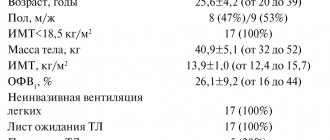Contraindications
Ambroxol should not be taken by people who have hypersensitivity to at least one component of the drug. Women in the first trimester of pregnancy should avoid taking it.
The drug in tablet form should not be used by people with stomach and duodenal ulcers, as well as in cases of epileptic syndrome.
Other contraindications include hereditary fructose intolerance. The medicine should not be taken for a dry cough that occurs with colds and viral diseases.
special instructions
To purchase medicine at a pharmacy you do not need a doctor's prescription. Shelf life – 3 years. Do not use after expiration date. Store at room temperature.
When using mucolytic drugs, it is advisable to drink as much liquid as possible: tea, compote, juices.
Patients with bronchial asthma should take a bronchodilator before inhalation to prevent irritation of the respiratory tract.
Taking tablets and syrup in parallel with antibiotics increases the content of the active component of the latter in the lung mucosa, which has a positive effect on the patient’s condition.
Ambroxol for pregnant women
Pregnant women should not take the drug only in the first 13 weeks of pregnancy. In the 2nd and 3rd trimester, you can use the medicine if the benefit to the expectant mother outweighs the threat to the fetus.
If we are talking about taking it while breastfeeding, then it is better not to use Ambroxol, since the active component can penetrate into the milk, and, consequently, into the baby’s body.
An interesting study was conducted in which results were obtained regarding the use of medication to treat problems with the respiratory system in an unborn baby. The constituent components are able to penetrate the placenta, which makes it possible to take the drug when the child begins to collect sputum in the lungs. Also, if you take Ambroxol during pregnancy, the baby activates the synthesis of pulmonary surfactant.
Instructions for use
Pills
The drug in tablet form is taken orally. You need to drink a small amount of drinking water.
Adults and children over 12 years of age can be given 1 tablet 2 times a day. In some cases, you can take 3 times a day.
In case of exacerbation of chronic diseases, you can increase the dosage to 2 tablets 2 times a day.
Cough tablets can be given to children from 6 years of age. From 6 to 12 years old you can give half a tablet 3 times a day.
The duration of treatment depends on the severity of the disease and the individual reaction of the body. On average it takes 10-12 days.
Syrup
Children over 12 years of age and adults can take 10 ml of syrup during the first 2 days of illness. Then you can take 5 ml 3 times a day.
The dose for children under 12 years of age is determined taking into account age. A child aged 5-12 years can be given 5 ml 2 times a day. In case of severe disease, the dosage frequency can be increased to 3.
If the doctor has prescribed long-term treatment, it is better to reduce the dose by half.
For inhalation and injection
An adult can take no more than 2 inhalations per day using 3 ml of solution. A child over 5 years old should take 1 inhalation per day using 2 ml of solution.
If the medicine is used for injection, the dosage for an adult patient is 40-60 mg per day, divided into 3 doses per day.
Injections are usually given into a muscle or vein, but they can also be administered subcutaneously.
The mechanism of action of ambroxol is multifactorial
It helps to liquefy bronchial secretions by breaking down acidic mucopolysaccharides and deoxyribonucleic acids, activates the movement of cilia of the ciliated epithelium, exerting a secretomotor effect and restoring mucociliary transport.
The drug has anti-inflammatory and antioxidant properties associated with its effect on the release of oxygen radicals and interference with the metabolism of arachidonic acid at the site of inflammation [39]. It may inhibit the release of mediators involved in allergic inflammation [40]. A very important property of ambroxol is the ability to increase the amount of surfactant, increasing its synthesis and inhibiting its breakdown in type 2 alveolar pneumocytes [41]. Surfactant plays an important role in maintaining the surface tension of the lungs and improving their compliance. Being a hydrophobic boundary layer, it facilitates the exchange of non-polar gases, has an anti-edematous effect on the alveolar membranes and ensures the stability of alveolar cells during respiration [36].
Surfactant is an important factor in the local protection of the lungs, preventing the penetration of pathogenic microorganisms into epithelial cells [41]. It is involved in ensuring the transport of foreign particles from the alveoli to the bronchi, where mucociliary transport begins, and improves the “sliding” of bronchopulmonary secretions along the epithelium of the bronchial mucosa [31, 36]. Thus, by increasing the amount of surfactant, ambroxol indirectly enhances mucociliary transport.
There is evidence that ambroxol normalizes the functions of altered serous and mucosal glands of the bronchial mucosa, reduces mucosal cysts and activates the production of the serous component [31]. This effect of the drug is especially important for patients with chronic lung diseases, who experience hypertrophy of the bronchial glands with the formation of cysts and a decrease in the number of serous cells.
Ambroxol differs from derivatives of acetylcysteine and partially bromhexine
Ambroxol differs from acetylcysteine derivatives and partially bromhexine in that it does not provoke bronchospasm [31, 38, 42]. Moreover, in a double-blind, placebo-controlled, parallel study, the ability of ambroxol to reduce bronchial hyperreactivity was proven [43], and in another study, its use was able to demonstrate a statistically significant improvement in external respiratory function indicators and a decrease in hypoxemia in patients with bronchial obstruction [44] .
The advantage of ambroxol over acetylcysteine is that it has an immunomodulatory effect, which helps strengthen local immunity. Ambroxol not only does not suppress the production of secretory IgA, but, on the contrary, increases it. It also activates tissue macrophages. The drug is able to inhibit the production of inflammatory mediators interleukin-1 and tumor necrosis factor [45] and stimulate the activity of macrophages [46]. It has been suggested that inhibition of the synthesis of proinflammatory cytokines can improve the course of leukocyte-mediated pulmonary injury [31]. In vitro experiments showed the inhibitory effect of ambroxol on neutrophil chemotaxis [47].
Ambroxol is one of two mucolytics (the second drug is domiodol), the use of which in adequate clinical studies has proven subjective improvement in the condition of patients with exacerbation of COPD [60].
The high efficiency and good tolerability of ambroxol, as well as the significant degree of patient adherence to treatment, allow some foreign authors to recommend it as the drug of choice for the prevention of chronic bronchitis [57]. Russian specialists who studied the effectiveness of ambroxol in outpatients with COPD also came to the conclusion that the mucolytic properties of the drug are maximally realized in dys- and hypercrinia, i.e. in patients with chronic bronchitis [61].
References Scott EG, Powell KR. Acute Otitis Media. Infect Med 2003;20:224–29. Berman S. Otitis media in children. N Engl J Med 1995;332:1560–65. Pauwels RA, Buist AS, Calverly PM, Jenkins CR, Hurd SS, for the GOLD Scientific Committee. Global strategy for the diagnosis, management, and prevention of chronic obstructive pulmonary disease: NHLBI/WHO Global Initiative for Chronic Obstructive Lung Disease (GOLD) Workshop summary. Am J Respir Crit Care Med 2001;163:1256–76. US Bureau of the Census. Statistical Abstract of the United States. (14th edn). Washington, DC, US Bureau of the Census, 1994/1995. Lange P, Groth S, Nyboe J, et al. Chronic obstructive lung disease in Copenhagen: Cross-sectional epidemiological aspects. J Intern Med 1989;226:25–32. Bakke P, Baste V, Hanoa R, Gulsvik A. Prevalence of obstructive lung disease in a general population: Relation to occupational title and exposure to some airborne agent. Thorax 1991;46:863–70. Brotons B, Perez J, Sanchez-Toril F, et al. Prevalencia de la enfermedad obstructiva cronica y el asma: estudio transversal. Arch Bronconeumol 1994;30:149–52. Lundback B, Nystrom L, Rosenhall L, Stjernberg N. Obstructive lung disease in northern Sweden: Respiratory symptoms assessed in a postal survey. Eur Respir J 1991;4:257–66. Aisanov Z.R., Kokosov A.N., Ovcharenko S.I., Khmelkova N.G., Tsoi A.N., Chuchalin A.G., Shmelev E.I. Chronic obstructive pulmonary diseases. Federal program // Consilium medicum. 2000. T. 2. No. 1. Hurd S. The impact of COPD on lung health worldwide: epidemiology and incidence. Chest. 2000;117(suppl.2):1–4S. Fennelly K.P., Stuhlbarg M.S. Chronic bronchitis // Pulmonology. 1994. No. 2. P. 6–13. American Thoracic Society. Standards for diagnosis and care of patients with chronic obstructive pulmonary disease. Definitions, epidemiology, pathophysiology, diagnosis, and staging. Am J Respir Crit Care Med 1995;152(suppl.):S78–120. Morbidity and Mortality: 1996 Chartbook on Cardiovascular, Lung and Blood Diseases. Bethesda, Md: National Heart, Lung, and Blood Institute, National Institutes of Health; May 1996:14. Enright PL, Kronmal RA, Higgins MW, Schenker MB, Haponik EF. Prevalence and correlates of respiratory symptoms and disease in the elderly. Cardiovascular Health Study. Chest 1994;106:827–34. Woolcock AJ. Epidemiology of chronic airways disease. Chest 1989;96(suppl. 3):302–06S. Higgins MW, Thorn T. Incidence, prevalence and mortality: intra- and intercountry differences. In Hensley MJ, Saunders NA, eds. Clinical Epidemiology of Chronic Obstructive Pulmonary Disease. New York: Marcel Dekker; 1990:23–43. Turner-Warwick M, Hodson ME, Corrin B, Kerr IH. Clinical Atlas of Respiratory Diseases. London: Gower Medical Publishing, 1990. Marcos MA, Jimenez de Anta MT, de la Bellacasa JP, Gonzalez J, Martinez E, Garcia E, Mensa J, de Roux A, Torres A. Rapid urinary antigen test for diagnosis of pneumococcal community- acquired pneumonia in adults. Eur Respir J 2003;21:209–14. Chuchalin A.G. Respiratory diseases // Med. newspaper. 2000. No. 43. pp. 8–9. Bariffi F, Sanduzzi A, Ponticiella A. Epidemiology of lower respiratory tract infections. J Chemother 1995;7:263–76. Bartlett J, Mundy L. Community-acquired pneumonia. N Engl J Med 1995;333:1618–24. Niederman MS, McCombs S, Unger AN, Kimar A, Popovian R. Treatment cost of acute exacerbations of chronic bronchitis. Clin Ther 1999;21:576–92 Szucs T. The socio-economic burden of influenza. J Antimicrob Chemother 1999;44(suppl. B):11–5. Darrow DH, Dash N, Derkay CS. Otitis media: concepts and controversies. Curr Opin Otolaryngol Head Neck Surg 2003;11:416–23. Antimicrobial Treatment Guidelines for Acute Bacterial Rhinosinusitis. Otolaryngol Head Neck Surg 2004;130(suppl.):S1–45. Sullivan SD, Ramsey SD, Lee TA. The economic burden of COPD. Chest 2000;117(suppl. 2):5–9S. Gonnzales R, Steiner JF, Sande MA. Antibiotic prescribing for adults with colds, upper respiratory tract infections, and bronchitis by ambulatory care physicians. JAMA 1997;278:901–04. Guillemot D, Carbon C, Vauzelle-Kervroedan F, et al. Inappropriateness and variability of antibiotic prescription among French office-based physicians. J Clin Epidemiol 1998;51:61–68. Mainous AG, Hueston WJ, Love MM, et al. An evaluation of statewide strategies to reduce antibiotic overuse. Fam Med 2000;32:22–29. Ovcharenko S.I. Mucolytic (mucoregulatory) drugs in the treatment of chronic obstructive pulmonary disease // Breast Cancer. 2002. T. 10. No. 4. Zaitseva O.V. Mucolytic therapy in the complex treatment of respiratory diseases in children // Consilium medicum. Pediatrics. 2002. T. 5. No. 10. Belousov Yu.B., Omelyanovsky V.V. Clinical pharmacology of respiratory diseases in children: A guide for doctors. M., 1996. 176 p. Vestbo J., Prescott E., Lange P. Association of chronic mucus hypersecretion with FEV1 decline and chronic obstructive pulmonary disease morbidity. Copenhagen City Heart Study Group. Am J Respir Crit Care Med 1996;153:1530–35. Prescott E, Lange P, Vestbo. Chronic mucus hypersecretion in COPD and death from pulmonary infection. Eur Respir J 1995;8:1333–38. Dvoretsky L.I. Chronic obstructive pulmonary diseases: the place of drug therapy // In the world of drugs. 2000. No. 1. Samsygina G.A., Zaitseva O.V. Bronchitis in children. Expectorant and mucolytic therapy. A manual for doctors. M., 1999. Korovina N.A. et al. Antitussive and expectorant drugs in the practice of a pediatrician: rational choice and tactics of use: A manual for doctors. M., 2002. 40 p. Zaitseva O.V. Mucolytic drugs in the treatment of respiratory diseases in children: a modern view of the problem // RMJ. 2003. T. 11. No. 1. Gillissen A, Nowak D. Characterization of N-acetylcysteine and ambroxol in anti-oxidant therapy. Respir Med 1998;92:609–23. Kupczyk M, Kuna P. Pol Merkuriusz Lek 2002;12:248–52. Geppe N.A., Malakhov A.B. Mucolytic and antitussive drugs in pediatric practice (lecture) // Children's doctor. 1999. No. 4. Samsygina G.A. Antitussive therapy: a rational choice // In the world of drugs. 1999. T. 2. No. 4. Melillo G, Cocco G. Ambroxol decreases bronchial hyperreactivity. Eur J Respir Dis 1986;69:316–20. Wiessmann KJ, Niemeyer K. . Arzneimittelforschung 1978;28:918–21. Bianchi H, et al. Ambroxol inhibits interleukin 1 and tumor necrosis factor production in human mononuclear cells. Agents Actions 1990;31:275–79. Capsoni F, Ongari AM, Minonzio F, Lazzarin A, Zavattini G. Effect of ambroxol on human phagocytic cell function. Boll Ist Sieroter Milan 1985;64:236–39. Stockley RA, Shaw J, Burnett D. Effect of ambroxol on neutrophil chemotaxis in vitro. Agents Actions 1988;24:292–96. Principi N, Zavattini G, Daniotti S. Possibility of interaction among antibiotics and mucolytics in children. Int J Clin Pharmacol Res 1986;6:369–72. Spatola J, Poderoso JJ, Wiemeyer JC, et al. Influence of ambroxol on lung tissue penetration of amoxicillin. Arzneimittelforschung 1987;37:965–66. Peralta J, Poderoso JJ, Corazza C, et al. Ambroxol plus amoxicillin in the treatment of exacerbations of chronic bronchitis. Arzneimittelforschung 1987;37:969–71. Paganin F, Bouvet O, Chanez P, et al. Evaluation of the effects of ambroxol on the ofloxacin concentrations in bronchial tissues in COPD patients with infectious exacerbation. Biopharm Drug Dispos 1995;16:393–401. Prevention of chronic bronchitis exacerbations with ambroxol (mucosolvan retard). An open, long-term, multicenter study in 5,635 patients. Respiration 1989;55(suppl. 1):84–96. Poole PJ, Black PN. The effect of mucolytic agents on exacerbation frequency in chronic bronchitis. Cochrane Review,. In: The Cochrane Library. Oxford: Update Software. 15 May 1998. Poole PJ, Black PN. Mucolytic agents for chronic bronchitis or chronic obstructive pulmonary disease. Cochrane Database Syst Rev 2003;2:CD001287. Poole PJ, Black PN. Preventing exacerbations of chronic bronchitis and COPD: therapeutic potential of mucolytic agents. Am J Respir Med 2003;2:367–70. Olivieri D, Zavattini G, Tomasini G, et al. Ambroxol for the prevention of chronic bronchitis exacerbations: long-term multicenter trial. Protective effect of ambroxol against winter semester exacerbations: a double-blind study versus placebo. Respiration 1987;51(suppl. 1):42–51. Michnar M, Milanowski J. . Pneumonol Alergol Pol 1996;64(suppl. 1):90–96. 58. Puscinska E, Radwan L, Zielinski J. Pneumonol Alergol Pol 1994;62:246–49. Malerba M, Ponticiello A, Radaeli A, Bensi G, Grassi V. Effect of twelve-month therapy with oral ambroxol in preventing exacerbations in patients with COPD. Double-blind, randomized, multicenter, placebo-controlled study (the AMETHIST Trial). Pulm Pharmacol Ther 2004;17:27–34. Bach PB, Brown C, Gelfand SE, McCrory DC. Management of acute exacerbations of chronic obstructive pulmonary disease: a summary and appraisal of published evidence. Ann Intern Med 2001;134:600–20. Novikov Yu. K., Belevsky A. S. Mucolytics in the complex treatment of COPD // Attending physician. 2001. No. 2. Baldini G, Gucci M, Taro D, Memmini C. . Minerva Pediatr 1989;41:91–95. Fegiz G. Prevention by ambroxol of bronchopulmonary complications after upper abdominal surgery: double-blind Italian multicenter clinical study versus placebo. Lung 1991;169:69–76. Romanini BM, Sandri MG, Tosi M, Mezzetti M, Mazzetti A. Ambroxol for prophylaxis and treatment of bronchopulmonary complications after chest surgery. Int J Clin Pharmacol Res 1986;6:123–27. Kimya Y, Kucukkomurcu S, Ozan H, Uncu G. Antenatal ambroxol usage in the prevention of infant respiratory distress syndrome. Beneficial and adverse effects. Clin Exp Obstet Gynecol 1995;22:204–11. Wolff F, Bolte A. Geburtshilfe Frauenheilkd 1990;50:171–76. Wauer RR, Schmalisch G, Bohme B, Arand J, Lehmann D. Randomized double blind trial of Ambroxol for the treatment of respiratory distress syndrome. Eur J Pediatr 1992;151:357–63. Laoag-Fernandez JB, Fernandez AM, Maruo T. Antenatal use of ambroxol for the prevention of respiratory infant distress syndrome. J Obstet Gynaecol Res 2000;26:307–12. Taganovich A.D., Kotovich I.L., Borodina G.L., Semenkova G.N. The influence of complex therapy with the use of ambroxol on the components of bronchoalveolar lavage in patients with sarcoidosis of the respiratory system // BMZh. 2002. No. 1. Mira E, Benazzo M, De Paoli F, Casasco A, Calligaro A. [Surfactants of the airways. Critical review and personal research]. Acta Otorhinolaryngol Ital 1997;17(suppl. 56):3–16. Passali D, Zavattini G. Multicenter study on the treatment of secretory otitis media with ambroxol. Importance of a surface-tension-lowering substance. Respiration 1987;51(suppl. 1):52–59. De Pra M, Oberti F. Minerva Pediatr 1990;42:515–30.
Adverse reactions and overdose
Side effects after taking the drug appear extremely rarely. Ambroxol has no toxic effect and is well absorbed in the human body.
In rare cases, skin problems may occur, manifested by a rash, as well as allergies, angioedema, lethargy and headache.
When taken simultaneously with incompatible drugs, isolated cases of severe skin lesions have been recorded.
In case of overdose, the patient experiences vomiting, nausea, and diarrhea. If such symptoms appear, you need to induce vomiting and rinse the stomach as quickly as possible. Then for a couple of days you need to eat food that contains fats.
In what cases is it used?
The degree of elasticity and viscosity of sputum can only be determined by how easily it is expectorated.
Ambroxol is especially effective for respiratory diseases and conditions in which phlegm appears and accumulates in the lungs.
The drug can be used for the following conditions:
- pneumonia;
- acute or chronic bronchitis;
- laryngitis;
- asthma;
- rhinitis;
- pharyngitis;
- respiratory tract disorder syndrome in newborns, including premature babies.






